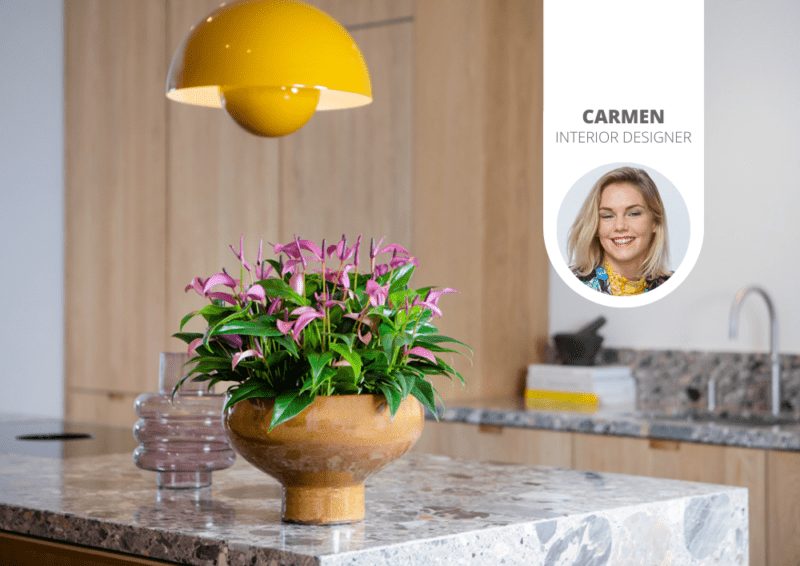How to take care of an Anthurium pot plant and cut flower
The Anthurium pot plant and cut flower are very easy to look after, as they need very little attention to keep looking beautiful for a long time. There are a few extra Anthurium plant care tips and tricks we’d like to share with you, so that you’ll enjoy your Anthurium plant or cut flowers even longer.
Anthurium plant care
The best spot for a happy plant
Anthuriums like to stand in a well-lighted place, but don’t like direct sunlight. When the plant is positioned in the dark, it will give fewer flowers. They love warmth and are happiest at a temperature between 18°C and 22°C. The minimum temperature for both the pot plant and cut flower is 16°C. Keep them away from draughts and don’t place them close to a hot radiator. Anthuriums really prefer high humidity, so for example in the bathroom is where they feel most at home.
Also read: Home decorating tips: how to use Anthurium plants
Anthurium plant care tips
In the winter period, the Anthurium plant should be watered once a week. In the summer, it can be watered more frequently, but twice a week should be enough. But always check the potting compost first. If Anthuriums are watered too often, they become waterlogged. This can cause the roots to rot. So, use well-draining compost and water your plant only when the compost feels fairly dry. Do you want to pamper your plant? Spray it now and then with a plant spray, so that it imagines its in the tropics.
Anthurium cut flower care tips
After buying the flowers, cut 5 cm off the end of the stalk and put the flower(s) in a clean vase with tap water. Anthurium flowers are very clean and keep the water clear. They don’t need cut flower food, but do tolerate it. So with bouquets of mixed flowers, you can add some cut flower food without any problem. Refresh the water in the vase of the Anthuriums about once a week, and cut one centimeter off the stem at the same time. This will ensure the Anthurium easily blooms for two to three weeks. Long-lasting enjoyment, without dirty vases or a lot of hassle!
Also see: Anthurium flowers in 3 entirely different interiors
Anthuriums bloom all year round
With the right care and regular fertilisation, the Anthurium plant produces new flowers throughout the year. Usually however there are cycles of three months of flowering, a few months without flowering, and then three months of flowering again. When the plant has shiny leaves and is producing new flowers, you can assume that they are enjoying favorable conditions and will flower for many years! Do you want to know more about flowering? Then read: how to produce new flowers.
What to do with coloured leaves?
When an Anthurium plant has brown leaves and leaf tips, it’s getting too much or too little water. Before you give water, feel how moist the soil in the pot is. If it feels rather dry, the plant needs some water. But if the soil is moist, wait a week before watering again. Before watering, it would be best to check the potting compost. If the potting compost feels fairly dry, the Anthurium could use a splash of water; if the potting compost feels moist, however, this can wait another week.
Are the leaves yellowish? Then it’s likely that the Anthurium is getting too much sunlight and needs to be moved further away from the window. Are new flowers coming, but do they stay green? Then it’s getting too little light and it needs to be moved closer to the window. Dead flowers, old and yellowed leaves can be cut off, because then the Anthurium can produce new flowers. How great is that?
Also read: What to do if the leaves of your anthurium become discoloured?
Repotting an Anthurium plant
If your Anthurium has grown too big for its pot, repotting is a good idea. Do this preferably in spring, because the lighter days stimulate the formation of buds. Place the plant in a pot with a diameter of at least 20% wider than the previous one, and use special Anthurium soil to do this. If you are going to repot your plant, mix in a bit of Anthurium feed at the same time so that the plant has a bit in reserve for growing.
If you have other Anthurium plant care related questions, please refer to our FAQs.
Save this article on Pinterest:

